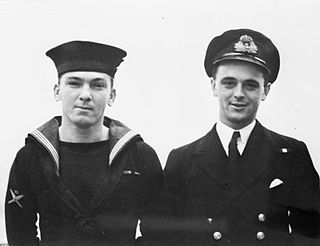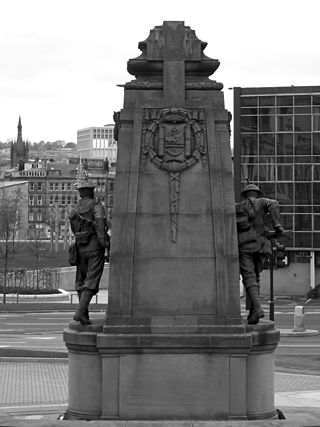
The Tower Hill Memorial is a pair of Commonwealth War Graves Commission memorials in Trinity Square Gardens, on Tower Hill in London, England. The memorials, one for the First World War and one for the Second, commemorate civilian, merchant seafarers and fishermen who were killed as a result of enemy action and have no known grave. The first, the Mercantile Marine War Memorial, was designed by Sir Edwin Lutyens and unveiled in 1928; the second, the Merchant Seamen's Memorial, was designed by Sir Edward Maufe and unveiled in 1955. A third memorial, commemorating merchant seamen who were killed in the 1982 Falklands War, was added to the site in 2005.

James Joseph Magennis, VC was a Belfast-born sailor and recipient of the Victoria Cross, the highest award for gallantry in the face of the enemy that can be awarded to British and Commonwealth forces. He was the only native of Northern Ireland to receive the Victoria Cross in the Second World War.

The Polish Air Force Memorial is a war memorial in West London, England in memory of airmen from Poland who served in the Royal Air Force as part of the Polish contribution to World War II. Over 18,000 men and women served in the Polish squadrons of the RAF during the war, and over 2,000 died. The memorial marks the southern extremity of South Ruislip in the London Borough of Hillingdon, near RAF Northolt, where seven Polish-manned fighter squadrons were based at different times in the war.
West Hartlepool War Memorial or Victory Square War Memorial or Victoria Square Cenotaph is a war memorial in Hartlepool, County Durham, England commemorating those from West Hartlepool who died in World War I and World War II. The war memorial, created in the 1920s, is located on Victoria Road in Hartlepool's Victory Square. The square was created for this monument.

The Machine Gun Corps Memorial, also known as The Boy David, is a memorial to the casualties of the Machine Gun Corps in the First World War. It is located on the north side of the traffic island at Hyde Park Corner in London, near the Wellington Arch, an Equestrian statue of the Duke of Wellington, the Royal Artillery Memorial, the New Zealand War Memorial, and the Australian War Memorial.

Rockingham Naval Memorial Park is a military memorial in the City of Rockingham, Western Australia, dedicated to the Royal Australian Navy. It contains a number of commemorative plaques, a 110 mm (4.5 in) gun turret from HMAS Derwent and a submarine fin from HMAS Orion.

Frederick Brook Hitch (1897–1957) was a British sculptor, the son of the architectural sculptor Nathaniel Hitch. He attended the Royal Academy Schools and was a Fellow of the Royal Society of British Sculptors. He lived in Hertford, Hertfordshire, England.

The Imperial Camel Corps Memorial is an outdoor sculpture commemorating the Imperial Camel Corps, located in Victoria Embankment Gardens, on the Thames Embankment to the east of Charing Cross station, in London, England. The unit of mounted infantry was created in December 1916 from troops that had served in the Gallipoli campaign in the Dardanelles.

The Anglo-Belgian Memorial, also known as the Belgian Gratitude Memorial, Belgian Refugees Memorial, or the Belgian Monument to the British Nation, is a war memorial on Victoria Embankment in London, opposite Cleopatra's Needle. It was a gift from Belgium, as a mark of thanks for assistance given by the UK during the First World War, and in particular for sheltering thousands of Belgian refugees who fled from the war. It is a Grade II* listed building.

The Chindit Memorial is a war memorial in London, England, that commemorates the Chindit special forces, which served in Burma under Major General Orde Wingate in the Second World War. The memorial was erected in Victoria Embankment Gardens in 1990, near the Ministry of Defence headquarters, and also commemorates Wingate, who died on active service in Burma in 1944. It became a Grade II listed building in August 2020.

Coventry War Memorial stands at the centre of War Memorial Park, to the south of the city of Coventry in England. The memorial is a tapering tower 87 feet (27 m) high, completed in 1927. It was restored in 2011, and designated as a Grade II* listed building in January 2013. At the same time, the park was itself listed at Grade II, and the gates and gate posts at the park's main entrance were separately Grade II listed.

The Royal Artillery Boer War Memorial is located on the south side of The Mall in Central London, close to the junction with Horse Guards Road at the northeast corner of St James's Park. Unveiled in 1910, it marks the deaths of the 1,083 soldiers of the Royal Artillery who died in the Second Boer War from 1899 to 1902 It has been a listed building since 1970.

The Dulwich College War Memorial is located at the eastern front of Dulwich College on College Road in Dulwich in the London Borough of Southwark. It commemorates the alumni of the college who died in both the First and Second World Wars. The memorial was designed by W. H. Atkin-Berry, an alumnus of the college. It was unveiled on 17 June 1921, the Dulwich College Founder's Day, by Major General Sir Webb Gillman, and dedicated by the Dean of Durham, James Welldon. Gillman was an alumnus of the college, and Welldon had served as Master of Dulwich College from 1883 to 1885. It has been Grade II listed on the National Heritage List for England since May 2010. The heritage listing places the memorial within a "visual and contextual relationship" with the Grade II* listed Main College building.

Bradford War Memorial commemorates the 37,000 men the English city of Bradford who served in the British Armed Forces in the First World War. Many of the 5,000 dead had served in the two Bradford Pals battalions and were killed on 1 July 1916, the first day of the First Battle of the Somme. The stone pylon with bronze statues was unveiled on 1 July 1922, in Victoria Square, beside Prince's Way, to the northeast of the Grade II listed Queen Victoria Memorial. A bronze plaque was added after the Second World War, and the memorial also commemorates later conflicts. It stands between the National Media Museum and Alhambra Theatre, Bradford, and was Grade II listed in 2016.

A bronze statue of General Charles George Gordon by Hamo Thornycroft stands on a stone plinth in the Victoria Embankment Gardens in London. It has been Grade II listed since 1970. A similar statue stands at Gordon Reserve, near Parliament House in Melbourne, Australia, on its original tall plinth.

Streatham War Memorial is a war memorial to the war dead of the London district of Streatham in the two World Wars. It was unveiled in 1922, and is sited near the northwest corner of Streatham Common, London Borough of Lambeth, England.
The Bank of England War Memorial, in the internal Garden Court at the headquarters of the Bank of England in the City of London, commemorates the bank's staff who were killed while serving in the First World War and Second World War. It includes a bronze sculpture by Richard Reginald Goulden portraying Saint Christopher carrying the Christ Child. It became a Grade II listed building in 2017. The surrounding buildings of the bank are separately listed at Grade I.

The City of Portsmouth War Memorial, also referred to as the Guildhall Square War Memorial, is a First World War memorial in Guildhall Square in the centre of Portsmouth, Hampshire, on the south coast of England. Portsmouth was and remains a port and home to a major naval dockyard. The dockyard and the armed forces provided much of the employment in the area in the early 20th century. As such, the town suffered significant losses in the First World War. Planning for a war memorial began shortly after the end of the conflict and a committee was established for the purpose. It selected a site adjacent to a railway embankment close to the Town Hall and chose the architects James Gibson and Walter Gordon, with sculptural elements by Charles Sargeant Jagger, from an open competition.
The Statue of Queen Victoria stands on the sea front at the bottom of Grand Avenue in Hove on the south coast of England. The statue is one of 14 by Thomas Brock and was unveiled in February 1901, the month after Queen Victoria's death. It is a grade II listed building.

The Pearl Assurance War Memorial, also known as the Pearl Centre War Memorial, is a First World War memorial, designed by George Frampton for the Pearl Assurance Company. Erected in London in 1921, it was moved to Peterborough in 1991. It became a Grade II* listed building in 2019.




















